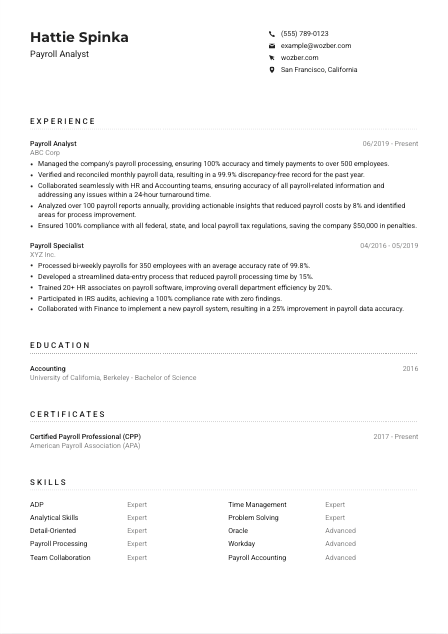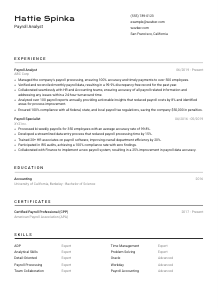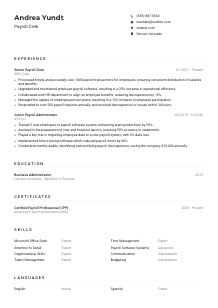Payroll Analyst CV Example
Crunching payroll numbers, but your CV isn't adding up? Delve into this Payroll Analyst CV example, structured with Wozber free CV builder. Learn how you can seamlessly integrate your financial flair with job requirements, making sure your career earnings always balance to the right decimal place!

How to write a Payroll Analyst CV?
Congratulations, future Payroll Analyst wizard! Embarking on this journey means you're ready to showcase your numerical prowess and detail-oriented mindset to potential employers. But to secure that role, your CV must not just inform—it must impress, resonate, and stand out in the bustling job market. Utilizing Wozber's free CV builder, this guide is your treasure map through the realm of CV crafting, specifically tailored for the Payroll Analyst position.
From embracing ATS-compliant CVs to choosing the ideal ATS-friendly CV template, we're diving deep into the art of CV optimisation. Ready to make every number and detail count? Let's sculpt your CV into a masterpiece that paves your way to success!
Personal Details
The Introduction is where you make your first impression, it's the professional handshake in your CV. Crafting this section with precision is key, especially for a Payroll Analyst role that emphasizes accuracy and detail. Let's walk through making your personal details not only accurate but a perfect fit for the job requirements.
1. A Name That Stands Out
Your name is essentially your brand. Opt for a clear, professional font and consider making it slightly larger than the rest of your CV text. This subtle emphasis makes your name memorable at a glance.
2. Title Match
Tailoring your job title to match the one in the job description ('Payroll Analyst' in our case) right below your name instantly signals to hiring managers that your qualifications align with their needs. It's a small tweak with significant impact.
3. Essential Contact Info
Your phone number and professional email address are crucial. Ensure your email follows the professional format of firstname.lastname@email.com, and double-check for typos to show that attention to detail that shines in a Payroll Analyst.
4. Location, Location, Location
For this San Francisco-based role, clearly stating 'San Francisco, California' in your contact details answers a key requirement, reassuring employers of your work logistics upfront.
5. The Professional Touch
Adding your LinkedIn profile or personal website, if it showcases your professional achievements or portfolio, adds depth to your CV. Ensure your LinkedIn mirrors your CV for coherence.
Takeaway
Think of the Introduction as the entry gate to your professional story. It's not just about personal facts; it's the preamble to your competencies and achievements. Keep it concise, professional, and perfectly aligned with the Payroll Analyst role. Now, let's move on to harnessing the power of your experiences with precision and flair.





Experience
The Experience section is where you truly sparkle. For a Payroll Analyst, this is the arena to prove your numerical accuracy, compliance savviness, and collaborative spirit. Follow these strategic steps to ensure your experience shines brightly and aligns perfectly with your desired Payroll Analyst position.
- Managed the company's payroll processing, ensuring 100% accuracy and timely payments to over 500 employees.
- Verified and reconciled monthly payroll data, resulting in a 99.9% discrepancy‑free record for the past year.
- Collaborated seamlessly with HR and Accounting teams, ensuring accuracy of all payroll‑related information and addressing any issues within a 24‑hour turnaround time.
- Analyzed over 100 payroll reports annually, providing actionable insights that reduced payroll costs by 8% and identified areas for process improvement.
- Ensured 100% compliance with all federal, state, and local payroll tax regulations, saving the company $50,000 in penalties.
- Processed bi‑weekly payrolls for 350 employees with an average accuracy rate of 99.8%.
- Developed a streamlined data‑entry process that reduced payroll processing time by 15%.
- Trained 20+ HR associates on payroll software, improving overall department efficiency by 20%.
- Participated in IRS audits, achieving a 100% compliance rate with zero findings.
- Collaborated with Finance to implement a new payroll system, resulting in a 25% improvement in payroll data accuracy.
1. Dissecting the Job Description
Initiate the process by dissecting the job description. For instance, 'Managed the company's payroll processing, ensuring 100% accuracy and timely payments' matches a core responsibility sought by employers for a Payroll Analyst.
2. The Pillars of Your Experience
List your experiences chronologically, starting with your current or most recent role. Include the job title, company name, and duration of employment, ensuring these pillars give a solid, easily navigable framework to your career timeline.
3. Concise Achievement Bullets
For each role, detail your achievements, using bullet points for clarity. Illustrate your claims with specific examples, like 'Ensured 100% compliance with federal, state, and local payroll tax regulations,' highlighting your ability to navigate complex payroll systems.
4. Quantifying Success
Whenever possible, add numbers to your achievements. ‘Analyzed over 100 payroll reports annually…reduced payroll costs by 8%' provides tangible proof of your ability to make a significant impact.
5. Relevance is Key
Maintain focus on experiences directly related to payroll analysis. While it's tempting to include unrelated achievements, relevance rules in portraying you as the ideal candidate for a Payroll Analyst role.
Takeaway
Your Experience section is a narrative of your professional journey through the lens of a Payroll Analyst. It's about demonstrating how each role you've held has been a step towards perfecting the skills and expertise needed for the position you're targeting. Tailor each bullet point with purpose, quantify your impact, and be ready to impress potential employers with your precision and dedication.
Education
In the world of Payroll Analysts, your educational background is the foundation upon which your expertise is built. While it might seem straightforward, presenting your education in a way that resonates with the employer's needs can set you apart. Here's how to sculpt your education section to underscore your qualifications for a Payroll Analyst position.
1. Align with Job Specifications
The job asks for a 'Bachelor's degree in Accounting, Finance, or related field.' Begin by highlighting your degree that matches this requirement, showcasing you have the academic foundation deemed essential for the role.
2. Structure Matters
Present your educational details succinctly - the degree obtained, your field of study, and the institution's name, followed by your graduation date. This clarity makes it easier for hiring managers to assess your educational qualifications at a glance.
3. Degree Specifics
If your degree closely matches one of the preferred fields mentioned in the job description, like 'Bachelor of Science in Accounting,' make sure to list it verbatim. This mirrors the job's requirements and highlights your relevant educational background.
4. Beyond the Degree
Listing relevant coursework, honors, or academic projects can be beneficial, especially if they directly relate to payroll processing or financial management. However, keep it brief and pertinent to maintain focus on the job's core requirements.
5. Certifications as a Bonus
While this section focuses on formal education, don't miss the opportunity to highlight any payroll-specific certifications here or in a separate Certificates section. This shows your continuous commitment to your professional development.
Takeaway
Your education isn't just about the institutions you've attended; it's about showcasing the relevancy of your academic achievements to the Payroll Analyst role. Tailor this section to reflect the job's requirements, demonstrating that you're not just qualified, but uniquely prepared for the challenges and responsibilities of the position.
Certificates
In the continually evolving payroll field, certifications can significantly bolster your credentials, especially for a Payroll Analyst. These endorsements of your skills not only keep you competitive but speak volumes about your dedication and proficiency. Let's navigate listing them effectively.
1. Certificate Relevance
'Certification in Payroll (CPP) or related professional certifications are preferred.' If you hold a CPP or similar credentials, give it prominence on your CV. This directly aligns with the employer's preferences and showcases your specialty in the field.
2. Key Certificates First
Highlight the most relevant certifications early in this section. If you're a Certified Payroll Professional (CPP), list it along with any other related accolades you've earned. Prioritize quality over quantity to keep the hiring manager's focus on your most impactful credentials.
3. Dates Matter
For certificates with expiration dates or those recently achieved, adding the date showcases the currentness of your expertise. It indicates to employers that you are up to date with the latest payroll standards and practices.
4. Continuous Learning
The field of payroll is dynamic, with frequent updates to regulations and software. Highlight any recent or ongoing education to show your commitment to staying ahead in your field. This eagerness to learn signals a proactive approach to professional development.
Takeaway
Your certificates are badges of honor; they validate your expertise and commitment to your career as a Payroll Analyst. By carefully selecting and presenting your certifications, you make a compelling case for your candidacy, showcasing not just your skills, but your dedication to excellence and continuous improvement in the payroll domain.
Skills
The Skills section is your chance to succinctly showcase your professional strengths. For a Payroll Analyst, this area enables you to highlight both the hard and soft skills crucial for navigating the complexities of payroll processing and compliance. Here's how to refine this section for maximum impact.
1. Unpack the Job Ad
Start with pinpointing the skills explicitly mentioned in the job description. For example, 'Proficiency in using payroll software like ADP, Oracle, or Workday' underscores a need for software expertise, while 'strong analytical skills with a detail-oriented mindset' speaks to the soft skills required.
2. Skill Selection
Directly match your skills with those mentioned in the job description. If you're experienced with ADP, Oracle, and Workday, these should be at the forefront. Similarly, don't forget to include soft skills like 'team collaboration' and 'problem solving,' which are just as critical.
3. Prioritize and Organize
Resist the temptation to list every skill you possess. Focus on the most pertinent ones to the Payroll Analyst role, prioritizing them for easy reading. This selective presentation ensures the hiring manager sees your most relevant qualifications without having to sift through unrelated abilities.
Takeaway
The Skills section is your professional highlight reel. By carefully selecting and presenting your skills, you signal to the employer that you're not just a fit for the role but the perfect match. Embrace this opportunity to showcase your most impactful hard and soft skills, demonstrating the depth and breadth of your expertise as a Payroll Analyst.
Languages
In an increasingly globalized workplace, language skills can enhance your CV, potentially setting you apart from other candidates. While not always a front-line requirement for Payroll Analyst roles, highlighting your linguistic abilities can reflect well on your adaptability and cultural awareness. Let's articulate this effectively.
1. Job Description Check
Start by cross-referencing any language requirements or preferences mentioned in the job description. For example, 'The role requires proficient English speaking skills' clearly states an expectation, positioning English proficiency as a non-negotiable for the role.
2. Language Hierarchy
Position the languages as per their relevance to the job. With English proficiency being a requirement, it should be listed first, highlighting your capability in the primary language of the workplace. Any additional languages can follow.
3. Additional Languages
Even if not required for the role, mentioning other languages you're proficient in can be a plus, showcasing a broader communication skill set. Consider your audience and the potential for future roles that could benefit from multilingual skills.
4. Clarity in Proficiency
Be precise about your language proficiency levels. Terms like 'Native,' 'Fluent,' 'Intermediate,' and 'Basic' offer a clear understanding of your capabilities, allowing employers to gauge your potential effectiveness in diverse communication settings.
5. Scope Understanding
Recognize whether the role might involve regional or international interactions that could leverage your language skills. While primary for roles with a global focus, language abilities can underscore your versatility even in roles primarily centered on local operations.
Takeaway
Language skills are a unique facet of your professional profile, offering a glimpse into your capacity for communication and cultural assimilation. By articulating your abilities with clarity and relevance, you underscore your readiness not only for the Payroll Analyst role but for broader challenges within a global work environment.
Summary
Your CV summary is your elevator pitch, a concise encapsulation of your professional persona tailored specifically for the Payroll Analyst role. This section is your opportunity to grab the hiring manager's attention and convince them to take a closer look at your qualifications. Here's how to construct a summary that resonates.
1. Role Essence Grasp
Digest the core requirements and responsibilities from the job description. Understanding that the role demands 'strong analytical skills with a detail-oriented mindset,' and proficiency in payroll software sets the tone for your summary.
2. Introduction
Begin with a statement that encapsulates your professional identity as a Payroll Analyst. Highlighting over 6 years of experience in the field establishes your credibility and sets a foundation for detailing your expertise.
3. Key Achievements Highlight
Point out your most applicable skills and experiences, like 'Expertise in ADP, Oracle, and Workday,' and significant accomplishments such as 'ensuring 100% accuracy and compliance in payroll processing.' This illustrates your direct alignment with the role's requirements.
4. Brevity and Punch
While it's tempting to detail all your qualifications, remember to keep your summary concise—three to five lines are sufficient. Craft each sentence to pack a punch, ensuring every word contributes to presenting the most compelling picture of your candidacy.
Takeaway
Your summary is the narrative hook of your CV; it draws the hiring manager in and entices them to delve deeper into your qualifications. By strategically tailoring this section to echo the Payroll Analyst role's requirements, you position yourself as not just a candidate, but the candidate for the job. Let your summary reflect your achievements, your expertise, and the unique value you bring to the table.
Launching Your Payroll Analyst Journey
Kudos for navigating through the intricacies of crafting an ATS-compliant, position-tailored CV with the prowess of a seasoned Payroll Analyst. Armed with these insights, Wozber's free CV builder, ATS-friendly CV templates, and ATS CV scanner, you're now equipped to translate your qualifications into a compelling narrative that resonates with the expectations of potential employers. Your journey towards securing your ideal Payroll Analyst position is well underway. Fine-tune your CV, let it reflect your unique professional story, and step confidently into the world of opportunities that awaits.
Your expertise is invaluable, and the right role is out there, waiting for your application. Go forth, with precision and confidence, towards your next career milestone!

- Bachelor's degree in Accounting, Finance, or related field.
- Minimum of 3 years of experience in payroll processing, tax filing, and payroll accounting.
- Proficiency in using payroll software or related platforms like ADP, Oracle, or Workday.
- Strong analytical skills with a detail-oriented mindset.
- Certification in Payroll (CPP) or related professional certifications are preferred.
- The role requires proficient English speaking skills.
- Must be located in San Francisco, California.
- Manage and oversee the company's payroll processing, ensuring accurate and timely payments to employees.
- Verify and reconcile payroll data, addressing any discrepancies or issues that arise.
- Collaborate with HR and Accounting teams to ensure payroll-related information is accurate and up-to-date.
- Analyze payroll reports and provide insights on trends, costs, and areas for improvement.
- Stay updated on federal, state, and local payroll tax regulations to ensure compliance.















